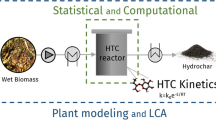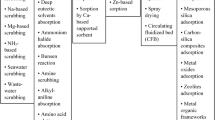Abstract
Considering the global warming potential of R-134a (C2H2F4) with the substantial generation of this refrigerant as waste material in various industrial sectors, the development of proper thermal destruction method of R-134a is of great practical significance. For this, experiment and numerical calculations have initially made for a tubular-type furnace in order to figure out the basic combustion characteristics of R-134a. A series of experimental investigations for the thermal decomposition of R-134a have been made as a function of wall temperature of tubular furnace and important reacting species such as O2 and H2O necessary for the decomposition of C2H2F4 into HF, CO2 and H2O. In general, the thermal decomposition of R-134a is successfully made for the condition of temperature above 800 °C with the supply of stoichiometric amount of O2 and these results are well agreed with numerical prediction. And this information is employed for the simulation of a full-scale, practical incinerator used for the CDM project. For this, numerical investigation has been made for a commercial-scale incinerator using CH4–air flames for the proper destruction C2H2F4 together with the control of pollutants such as CO and NO. In general, the destruction rate of C2H2F4 appears more than 99.99 % and the generation of CO and NO species appears rather sensitive to the operational condition such as amount of water vapor. The numerical method of HFCs (hydrofluorocarbons) thermal treatment shows high possibility as a viable tool for the proper design and optimal determination of the operational condition for a HFCs incinerator.








Similar content being viewed by others
References
Patankar SV (1980) Numerical heat transfer ans fluid flow. McGraw-Hill company, New York
Magnussen BF, Hjertager H (1976) On mathematical modeling of turbulent combustion with special emphasis on soot formation and combustion. In: 16th symposium (international) on combustion. The Combustion Institute, Pittsburgh, PA, p 714
Jang DS, Shin MS, Lee YG, Kim YJ (2015) On a thermal destruction of HFC-134a and HFC-23 by CH4 and water electrolysis gas in a CDM incinerator. In: The 2nd 3R international scientific conference on material cycles and waste management, DCC Daejeon, South Korea, pp 205–209
Sharifah AS, Abidin HZ, Sulaiman MR, Khoo KH, Ali H (2008) Combustion characteristics of Malaysian municipal solid waste and predictions of air flow in a rotary kiln incinerator. J Mater Cycles Waste Manage 10(2):116–123
Lee HS, Bae SK (2009) Combustion kinetics of sewage sludge and combustible wastes. J Mater Cycles Waste Manage 11:201–207
China Fluoro Technology Co. (2007) CDM monitoring report, UNFCCC (United Nations Framework Convention on Climate Change) CDM reference number 1194
Robinson JM (1981) Experimental sooting limits for methane-chlorinated hydrocarbon flames. M.S. Thesis, Massachusetts of Technology, Department of Chemical Engineering
Valerias HA (1982) Burning velocities and rates of methane chlorinated hydrocarbon flames. Master thesis, Chemical Engineering Dept, Massachusetts Institute of Technology
Shebeko YuN, Azatyan VV, Bolodyan IA, Navzenya VYu, Kopylov SN, Shebeko DYu, Zamishevski ED (2000) The influence of fluorinated hydrocarbons on the combustion of gaseous mixtures in a closed vessel. Combust Flame 121:542–547
Takizawa K, Takahashi A, Tokuhashi K, Kondo S, Sekiya A (2005) Burning velocity measurement of fluorinated compounds by the spherical-vessel method. Combust Flame 141(3):298–307
Lee J, Shim J (2013) Treatment of waste refrigerants by calcination reactor. Korea Patent No. 10-2013-0002125
Ha JS (2015) 2014 Annual report for the development of waste refrigerant separation/refinement, reclamation and thermal treatment presented for the R&D center for the reduction of non-CO2 green house gases, green chemistry and engineering, Korea Research Institute of Chemical Technology
Acknowledgments
This project is supported by the “R&D Center for reduction of non-CO2 Greenhouse gases (2013001690006)” funded by Korea Ministry of Environment (MOE) as “Global Top Environment R&D Program.”
Author information
Authors and Affiliations
Corresponding author
Rights and permissions
About this article
Cite this article
Shin, M., Jang, D. & Ha, J. Experimental and numerical calculations of waste R-134a thermal decomposition for energy and fluorine material recovery. J Mater Cycles Waste Manag 18, 399–406 (2016). https://doi.org/10.1007/s10163-015-0451-2
Received:
Accepted:
Published:
Issue Date:
DOI: https://doi.org/10.1007/s10163-015-0451-2




